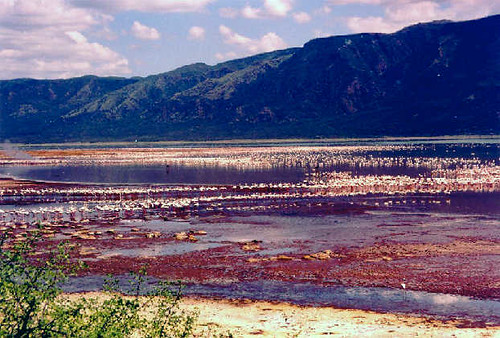I am back at Karen from lake Nakuru, but only for about an hour because then we are headed to Shompole for some quality time with the Maasai, including a boma homestay of two nights, not really sure what we are going to eat when we are there with them, but hey it should be an adventure. Lake Nakuru was amazing, we saw soooo many cool animals, including lots of white rhino, and one black rhino, 3 leopards, a pride of 7 lions and one mom lion with her two cubs, a lot of cape buffalo, and over 2 million flamingos. We were able to get really close to the animals. We took land cruisers, so we got to sit on the roof of them and get a good view of everything. One day we spent counting these cactus trees too. The trip went by fast, the weather was chilly in the late afternoon and evening but nice and warm during the day!

Info on Lake Nakuru from the internet:
Lake Nakuru is a small, shallow, alkaline-saline lake located in a closed basin without outlets in the Eastern Rift Valley of equatorial East Africa. It is the centre of a most familiar national park of Kenya known for its spectacular bird fauna (495 species), particularly the vast flock of lesser flamingo (Phoeniconaias minor). Being in the Rift Valley where tectonic and volcanic activities as well as climatic changes have been very remarkable, the lake underwent drastic changes during the recent geological ages. About 10,000 years ago, Nakuru and its two neighbor lakes, Elmenteita and Naivasha (60 km south of Nakuru), formed a single deep freshwater lake, which however dried owing to the later desiccation of climate leaving the three separate lakes as remnants. The present maximum depth is about three meters, but the lake water level is still quite variable; the whole lake had been almost dried up several times during the past 50 years (Fig. AFR-07-02) due to unknown reasons. The lake is a soda-lake with a water pH value of 10.5 and an alkalinity of 122 meq l-1. Main ions are sodium and bicarbonate-carbonate. The biota in the lake is very simple as in other saline lakes, consisting of phytoplankters dominated by blue-green algae and very poor planktonic and benthic fauna originally lacking fish. However, the lake is highly eutrophic owing to the vigorous growth of a planktonic blue-green alga, Spirulina platensis, which supports an immense number of alga.grazing lesser flamingo and an increasing population of the introduced fish, Sarotherodon alcalicum grahami, though, in the last several years since 1974, the planktonic productivity and the flamingo population decreased abruptly.

1 comment:
The only things I know about the Masai I learned from Hemingway's books and The Discovery Channel. I think we might have glanced at them in a class or two in college - I do know that cattle are their most important source of food, but not as meat. Far to valuable to slaughter. They drink the milk and also bleed the cattle in order to mix the blood with the milk. Supposedly, they also make a pretty nice stimulant/narcotic out of a local tree to aid them in their lion hunts.
Post a Comment